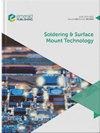冲击波条件下SAC305/CNT/CU焊点的微观结构演变及微观力学性能
IF 1.8
4区 材料科学
Q3 ENGINEERING, ELECTRICAL & ELECTRONIC
引用次数: 10
摘要
目的研究碳纳米管(CNT)的加入对冲击波条件下Sn-3.0Ag-0.5Cu(SAC305)/CNT/Cu焊点的微观结构、界面金属间化合物(IMC)层和微观力学性能的影响。这项工作是对先前研究Sn-Ag-Cu(SAC)焊料在冲击波条件下的微观结构演变和硬度性能的扩展。设计/方法/方法SAC/CNT焊膏通过将SAC焊料粉末、焊剂和CNT分别与0.02和0.04重量百分比(Wt.%)混合来制造。然后将这种焊膏印刷在具有铜表面光洁度的印刷电路板(PCB)上。印刷样品经过回流焊接以形成焊点。然后将焊接样品暴露于具有不同重量炸药装药的露天空气爆破试验中。通过光学显微镜、场发射扫描显微镜和纳米压痕等手段,对SAC/CNT焊点的微观结构、界面IMC层和冲击试验后的微观力学行为进行了观察和分析。发现爆炸波作用下SAC305/Cu和SAC/CNT/Cu焊点的微观结构不稳定。界面IMC层厚度和硬度特性随着炸药重量的增加而增加。SAC305焊接系统中CNT的存在增加了焊点对冲击波的抵抗力。SAC305/CNT/Cu焊点微观力学性能的独创性/价值响应已经确定,并为焊点的可靠性提供了基本的理解,特别是在极端条件下,如军事应用。本文章由计算机程序翻译,如有差异,请以英文原文为准。
Microstructural evolution and micromechanical properties of SAC305/CNT/CU solder joint under blast wave condition
Purpose
The purpose of this paper is to investigate the effect of carbon nanotube (CNT) addition on microstructure, interfacial intermetallic compound (IMC) layer and micromechanical properties of Sn-3.0Ag-0.5Cu (SAC305)/CNT/Cu solder joint under blast wave condition. This work is an extension from the previous study of microstructural evolution and hardness properties of Sn-Ag-Cu (SAC) solder under blast wave condition.
Design/methodology/approach
SAC/CNT solder pastes were manufactured by mixing of SAC solder powder, fluxes and CNT with 0.02 and 0.04 by weight percentage (Wt.%) separately. This solder paste then printed on the printed circuit board (PCB) with the copper surface finish. Printed samples underwent reflow soldering to form the solder joint. Soldered samples then exposed to the open field air blast test with different weight charges of explosives. Microstructure, interfacial IMC layer and micromechanical behavior of SAC/CNT solder joints after blast test were observed and analyzed via optical microscope, field emission scanning microscope and nanoindentation.
Findings
Exposure to the blast wave induced the microstructure instability of SAC305/Cu and SAC/CNT/Cu solder joint. Interfacial IMC layer thickness and hardness properties increases with increase in explosive weight. The existence of CNT in the SAC305 solder system is increasing the resistance of solder joint to the blast wave.
Originality/value
Response of micromechanical properties of SAC305/CNT/Cu solder joint has been identified and provided a fundamental understanding of reliability solder joint, especially in extreme conditions such as for military applications.
求助全文
通过发布文献求助,成功后即可免费获取论文全文。
去求助
来源期刊

Soldering & Surface Mount Technology
工程技术-材料科学:综合
CiteScore
4.10
自引率
15.00%
发文量
30
审稿时长
>12 weeks
期刊介绍:
Soldering & Surface Mount Technology seeks to make an important contribution to the advancement of research and application within the technical body of knowledge and expertise in this vital area. Soldering & Surface Mount Technology compliments its sister publications; Circuit World and Microelectronics International.
The journal covers all aspects of SMT from alloys, pastes and fluxes, to reliability and environmental effects, and is currently providing an important dissemination route for new knowledge on lead-free solders and processes. The journal comprises a multidisciplinary study of the key materials and technologies used to assemble state of the art functional electronic devices. The key focus is on assembling devices and interconnecting components via soldering, whilst also embracing a broad range of related approaches.
 求助内容:
求助内容: 应助结果提醒方式:
应助结果提醒方式:


